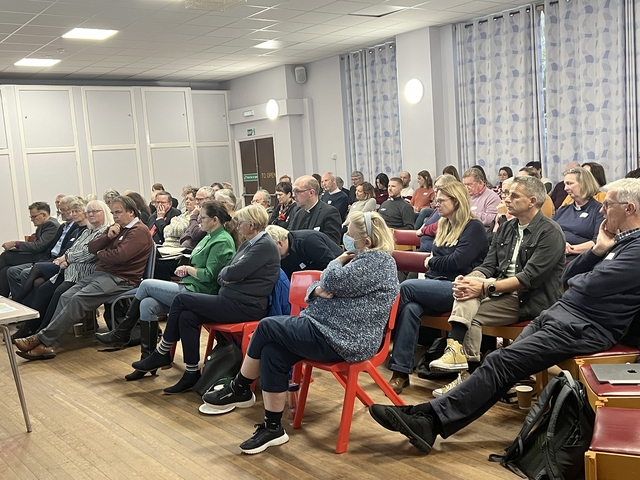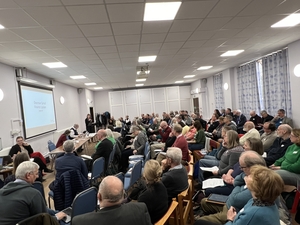
Diocesan Synod, November 2024
PRESIDENTIAL ADDRESS
Bishop Jonathan spoke about the assisted dying bill which is due to be debated in Parliament on November 29, noting that many of those present will have ministered to those who are dying and perhaps also cared for close family at the end of their lives. He said he was opposed to these changes and had written to all of the area's MPs with his views. He urged synod members to consider their responses and use resources to take action. There are details here.
He was also able to announce that the national Church of England had approved our bid for a major investment by the national Church to help us to deliver our strategic plans. This means we have extra funding of around £1m a year to spend on the delivery of our strategy. You can read more about that here.
NEW SET OF DIOCESAN SYNOD MEMBERS
Every three years, a new set of Diocesan Synod members is elected. This was the first meeting of a newly-elected synod, and each House has to elect a chair. The House of Bishops only has one member (Bishop Jonathan), so the other two Houses elected their chairs as follows:
- Chair of House of Clergy: Canon Bob White
- Chair of House of Laity: Debbie Sutton
Diocesan Secretary Philip Poulter also introduced synod members to an organisational diagram of staff, and spoke about elections to Bishop’s Council, our Vacancy-in-See Committee and our Patronage Board. Details here. Canon Bob White explained more about our synod’s standing orders.
SAFEGUARDING
Diocesan Secretary Philip Poulter updated synod members on safeguarding, referring to a visit by Alex Kubeyinje, the Church of England’s national director of safeguarding, Alex had indicated that our diocese’s safeguarding arrangements were the “gold standard” that other dioceses might want to follow, which was a morale-boost for our safeguarding team. Philip also gave an update on the process by which safeguarding might become more independent of the Church of England, which you can read more about here.
SUFFRAGAN BISHOP
Bishop Jonathan told synod members about an application that would be made to the Dioceses Commission to revive the See of the Isle of Wight, which was created in 1534 but never used. He explained that a new Bishop of the Isle of Wight could live on the island, share episcopal functions with the diocesan bishop, and be given a specific role in leading our new Ministry and Discipleship team. You can read the draft of our application to the Dioceses Commission here.
Among the justifications for this new role were:
- our diocese is small by area, but 34th in the country by population. Dioceses with smaller populations already have a suffragan bishop;
- we are unusual in that the Solent separates the Isle of Wight from the mainland in a way not shared by other dioceses;
- Bishop Jonathan has a significant national role as the lead bishop for education, and is likely to enter the House of Lords in 2025;
- Bishop Jonathan wishes to model collaborative leadership, especially in terms of the delivery of our strategy.
Synod members signalled their support for this application, which may or may not be successful. If a suffragan bishop is appointed, he or she would be funded by the Church Commissioners, apart from the provision of housing which would fall to the diocese.
NET ZERO CARBON ACTION PLAN
Environment officer David Cain told synod members about progress in achieving net zero carbon by 2030, in line with the resolution passed by General Synod in 2020. He explained that national funding had helped to create a new net zero carbon programme manager for Portsmouth, Guildford and Chichester dioceses (Steve Collins) alongside himself as half-time environmental officer and a half-time net zero carbon officer (Matt Lockwood).
They had put together a net zero carbon action plan which detailed how we might move away from dependency on fossil fuels. It can be read here. An amazing 100 per cent of parishes submitted their energy usage data via the Energy Footprint Tool (we are the only diocese where this happened) which puts us in a strong position to access funding streams. David took synod members through the data, which suggested different levels of emissions, depending on whether the heating system used electricity, gas or oil. The data had prompted them to work with those churches that emitted the most carbon, to find potential alternatives. David’s presentation is here.
GENERAL SYNOD
General Synod member Rebecca Hunt reported back from the July 2024 General Synod held in York, where members had talked about issues such as the importance of rest, the Clergy Conduct Measure, financial matters and the future of safeguarding in the Church of England. She also shared some of the General Synod’s discussions on Living in Love and Faith.
SDF/SMMI REPORT
The Rev Andrew Hargreaves, our interim director of Mission and Discipleship and Vanda Leary, our strategic programme manager, presented an update on our strategic projects. Previous strategic projects had been funded by the national Church via its Strategic Development Fund (SDF), but this had now been replaced by the Strategic Mission and Ministry Investment (SMMI) Board, who had just approved our most recent bid for funding. This would give us an investment of around £1m a year for the next five years, to help us to deliver on our strategic plans, and was a major vote of confidence by the national C of E in our ability to do this.
Andrew and Vanda explained that the implementation of our strategy would involve three strands:
- REVIVE: clergy and lay leaders meeting in ‘Cairns’ to eat, pray and study together. Details here.
- REVITALISE: the revitalisation of parish mission to ensure those outside the Church were engaged with, evangelised to become disciples and then equipped for mission themselves. This would include major projects in Paulsgrove and Leigh Park, training to create a new tranche of children and youth workers, new Choir Church projects, and a development of existing projects in Newport and Gosport. Details here.
- RENEW: the creation of new church plants and worshipping communities, including major church plants in Fareham and Portsmouth, new Flourish worshipping communities in schools, and ‘Myriad’ training across the diocese. Details here.
They also explained that a Lead for Revive, a Lead for Revitalise and a Lead for Renew would all be recruited to head up these areas of work, alongside new parish roles in places such as Paulsgrove and Leigh Park.
And a further bid for new SMMI funding would be submitted, probably in June 2026, which could incorporate details of further targeted parish revitalisation, another four or five major plants, and further developments of Choir Church and Flourish.
Their presentation is here.
LIVING IN LOVE AND FAITH
Synod members watched this video, in which the Bishop of Leicester, the Rt Rev Martyn Snow, explains the current situation with regard to the Church of England’s Living in Love and Faith process. It’s possible, depending on what happens in the General Synod debate in February 2025, that our Diocesan Synod will be asked to debate issues relating to marriage and sexuality between February and July 2025:
BUDGET 2025
Our diocese’s finance controller Elaine Coe presented details of our diocesan budget for 2025, based on the original paper she had presented, which is here, and an addendum put together after the government’s Budget earlier in the week. She explained that the £1m deficit forecast for 2024 was partly the result of the recruitment of more stipendiary clergy, which had pushed our expenditure up. It also tallied with the national Church of England where dioceses as a whole had deficits that added up to £62m. There was currently a review into how dioceses are being financed overall. Her presentation is here.
Bishop Jonathan conceded that this deficit could be seen as a similar financial situation to the one he inherited, but said there were some major differences: the financial controls and good order now in place (including the repayment of a £2m Covid business loan); the investment in people with many new clergy appointed recently; the organisational focus on vision and strategy; a renewed Parish Share scheme imminent; the introduction of Generosity Week; and the wide take-up of the Parish Giving Scheme.
The Budget for 2025 was drawn up with three potential scenarios, showing three different collection rates for parish share. It assumed a three per cent increase in the overall parish share requested, and a three per cent increase in clergy stipends and lay salaries. It also assumed that all stipendiary clergy posts will continue to be filled. Details are here.
In proposing the motion that Diocesan Synod accepts the budget, John Gwynn said this was a God-given opportunity for members to get behind the concept of parish share, and to mention the benefits of our system at each meeting they attend – to ensure the collection rate reaches 100 per cent next year. Synod members voted to accept the budget and in favour of raising £5.37m in parish share next year.
PARISH SHARE REVIEW GROUP
The Rev Sue Jones, who chairs our Parish Share Review Group, introduced a paper with its recommendations, which you can read here. She explained that the group had tried to make this exercise as collegiate as possible, consulting people and parishes with two separate questionnaires to ensure their ownership of the process. The new procedure for calculating parish share will apply for the first time in 2025.
Among the recommendations is one that suggests any parish that finds its parish share unaffordable should be able to have constructive dialogue with the Diocesan Secretary, alongside greater openness and transparency about finances overall.
The group decided that the calculations around parish share should still be based on a measure of Average Weekly Attendance, but calculated over a three, four and then five-year rolling average, to ensure all figures are post-Covid ones. It should also be based on relative affluence, based on the average net disposable income for each parish. Synod members were asked to decide if the ‘parish factor’ weighting should remain at 1:3 (meaning the most affluent parishes should be asked for no more than three times more than the least affluent parishes) or be increased to a ratio of 1:5. They voted for it to remain at 1:3.
Synod members heard there would also be comprehensive transitional arrangements to smooth over the effects of large changes, upwards or downwards, in the amount of parish share requested from each parish.
Diocesan Synod voted to accept the proposed changes. For full details, click here.
